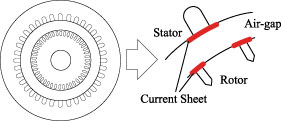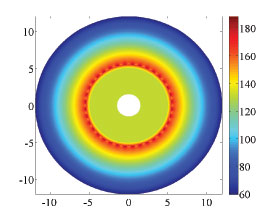Electric Machine Capabilities: A Thermal Approach
Our research goal is to understand the maximum short-term capabilities of electrical machines and investigate control methods to achieve them. Electric machine capabilities and limitations cannot be understood only through electrical specifications and nameplate data, because redundancy is included in the design. In order to obtain a thorough understanding of electromagnetic force/torque generation, one must consider thermal characteristics of the entire machine structure. Once thermal characteristics are accurately identified, this information can be used in a high-performance control algorithm to enforce maximum capabilities in a closed-loop control system.
Accurate thermal analysis can be obtained through finite element analysis; in this research analytical solution approaches will be used instead. The steady-state temperature distribution inside the machine can be formulated as Poisson’s equation. Geometry is assumed to be circular and windings are modeled as current sheets placed on the core surface. The induction machine geometry is shown in Figure 2. Poisson’s equation is solved analytically for geometry and temperature as shown in Figure 3. The results match experimental results found in the literature. These results are for steady-state solutions; a dynamic implementation requires transient modeling as well. This can be achieved by extending the analysis to a diffusion equation. Analytical solutions to a diffusion equation can be implemented in a real-time temperature estimator so that maximum capabilities can be globally enforced. Even though the approach is computationally intensive and comparably expensive, it shows promise for the future of electric vehicles and the aerospace industry. This research is supported by the Grainger Center for Electric Machinery and Electromechanics.

